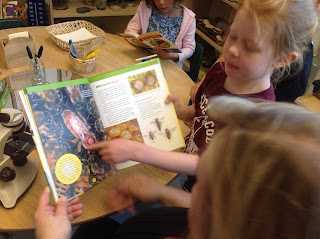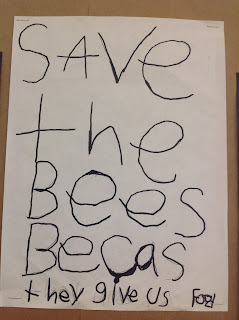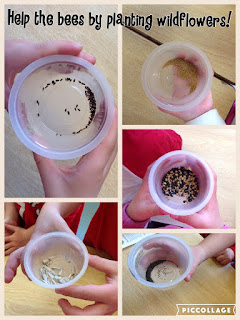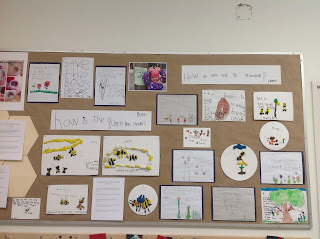While reading this lovely book about spring one child's question initiated a deep discussion about bees. We didn't even have time to finish the book!
“Why is there so much fruit and less bees?” C. D.
“When I go
to the grocery store I see so much fruit but outside I don’t see many bees and
bees make the fruit?” C. D.
“I think
it’s because they are getting hurt because the days are cold and only come in
the spring and they don’t have fur.” C. D.
“Bees are in
danger, my mom told me that farmers are putting pesticide on their plants and
they bees are getting it on them and killing them.” L. B.
“What is pesticide?” Mrs. Ralph
“It’s a type
of spray you put on plants and leaves.” M. S.
“It kills
the bees because it has bad stuff that kills the bees.” J. B.
“They die
from the spray because it has bad stuff for bees, people, and bugs.” D. F.
“The farmers
doesn’t want the bees to get all the flowers because they will die.” P. C.
“They use
pesticide because they don’t want bees around.” S. T.
“Bees are
really important because they need to make honey and don’t want people to get
sick. E. B.
“The
pesticide makes bees not make honey so they won’t make it through the winter
because honey makes them survive in the winter and it keeps them warm.” Z. G.
“They put
the pesticide on flowers so the bees die and don’t sting them.” C. D.
“It is a bad
idea because we won’t have honey.” P. C.
This was a very engaging conversation. A great start to some deep questions about bees. But now what? Where does one go from here in regards to extending this learning further? Below are a few suggestions that my teaching partner and I try and keep in mind as new sparks present themselves.
Giving Time...
As with many inquiry topics, there is a vast amount of factual knowledge than can be found from many different sources, but I have found that the key to sustaining and extending an inquiry is to allow for enough time for the children to be able to formulate their own ideas. Critical thinking and being able to express their reasoning is in my opinion one of the most important aspects of inquiry based learning. As the children looked at pictures in books, viewed videos, and supported each other through discussions, they were able to formulate and express their own ideas.
"Imagination is theory making" ~ Jason Avery
(Twitter: @inquirelee)
Ask yourself what the goal of the inquiry is? For us it is never solely about seeking correct answers. It is more about instilling a sense of wonder and curiosity that drives and motivates children to think critically and use the resources around them to guide their own learning. They are also able to support each other by taking part in group discussions and using new knowledge to either add to or refute their own theories. I can't imagine how much rich knowledge of the children's thinking I would have missed if I didn't give them the time to ponder things on their own.
Answering back with open ended questions opens the door for further investigation.
"What do you think?"
"How do you think they do that?"
"Where do you think they go?"
"Why does that happen?"
Open ended questions allows the learning to continue rather than stalling it. With so many wonderful books and other resources it was very tempting to give answers but I learned from experience that there is a balance in supporting children just enough so they continue to want to learn more.
Slowing Down and Stepping Back...
I feel an inquiry should follow the children's interests at the deeper level based around their observations, wonders, and theories. With the educators' guidance, children's thinking and learning can be made visible. For this process to be achieved, one must slow down and give time for children to explore and investigate the many resources provided to them. I really had to hold myself back in wanting to read and show them everything on honeybees. In slowing down and stepping back the children became more confident and independent in seeking out knowledge on their own or having discussions in small groups with their peers about their thinking. Rather than coming to myself or Mrs. Powell, the children used the resources in the classroom to guide their own theories and formulate new ideas.
Documenting the children's thinking has been beneficial in giving us a view into their level of understanding. Knowing where they are coming from in terms of their theories has greatly allowed us to be able to plan the type of supports and challenges needed to further their learning.
Documenting the children's thinking has been beneficial in giving us a view into their level of understanding. Knowing where they are coming from in terms of their theories has greatly allowed us to be able to plan the type of supports and challenges needed to further their learning.
How our honeybee inquiry unfolded...
After the initial discussion, we encouraged the children to write or draw their ideas on stickies and place them on the "I see, I wonder, I think" chart paper was placed on the wall at the Discovery Area. Once a week we read over the sticky note comments and discuss further.
Below are some of the prominent discussions the children had relating to some of their wonder questions and theories. These documented conversations supported our planning and gave us direction into the type of learning the children were fascinated with.
Conversations about pollen, nectar, and honey…
“How do bees
turn pollen into honey?” L. B.
“Bees get
their honey from the hives.” B. P.
“I wonder
how a beehive is made?” J. K.
“Bees pick
up nectar by the things on their head.” D. F.
“They get
the pollen on their body by going in the flower and rolling in it.” P. M.
“Why do
flowers have pollen?” F. D.
“When I was
looking I saw yellow dust. It’s pollen but I didn’t see nectar.” Z. G. when
inspecting our classroom tulip plant.
“Nectar is
like pollen it is on the inside of the flower. It was on my finger!” L. B.
“They carry
pollen in their pollen basket.” Z. G.
“Bees make
honey and they give it to the factory. They make it sweet. The factory people
hold out a jar and the bees drop it in.” B. P.
“I think
they drop the pollen into the honeycomb and it makes honey.” L. B.
“I think
nectar is what bees drink, it is a liquid.” F. D.
“I think the
bees eat pollen.” P. M.
“I think
bees give nectar to the babies and the pollen is to make honey.” C. D.
“If they
drink the nectar and give pollen to the babies what do they make honey with?”
F. D.
“They make
honey with the nectar and drink it too. Honey is made with pollen and nectar.”
B. P.
“I know how
bees get pollen, they lay down and get it on their stinger.” A. R.
“The bees
get her finger to get pollen and brings it back to the house.” F. W.
“They were
sucking pollen from my flowers in my garden.” S. T.
How do bees know who is the queen bee? F. D.
“Two bees
fight to see who get to be the queen bee. She takes care of the babies while
the others go get pollen.” L. B.
“If you win
the fight do you get to be a queen bee?” P. M.
“Yes and the
other goes to find another hive to be queen.” L. B.
“I think
they know because they watch the fight and whoever wins is the queen bee.” J.
K.
“They know
because they switch crowns with the old queen bee.” C. T. and M. S.
“I agree
with J. K. that they watch the fight to see who wins.” P. M.
“I think the
queen bee dances and tells them about what to do that’s how they know.” C. D.
“When they
see the fight they see the difference of how they look and remember when they
are in the hive.” L. B.
“The queen
bee looks like a big larva with a red face and stinger. How they decide is when
a queen bee lays an egg that is a bigger egg so they know the queen bee is
inside.” Z. G.
What happens to bees in the winter?
A wonder inspired by our poem
“Bees die in
the winter but before they die they lay eggs in the winter and hatch in the
spring.” C. C.
“I disagree
with C. C. because the larva need to be taken care of, they get hungry and
hungrier each day they stay in their hives in the winter. They don’t die. Z. G.
“I thing C.
C. means it’s a life cycle, before they die they lay eggs and then they hatch
in spring and are busy in the fall making honey.” C. D.
“I agree
with Z. G. because bees hibernate in the winter.” D. F.
How do bees help give us food?
Mrs. Ralph
“Fruits
start as flowers and the bees help them grow and help flowers open up. The
flower grows into a plum and it loses all their petals!” R. S.
“When they
put honey on the fruit we taste the sweet part.” F. D.
“Flowers are
flowers and then it goes into apples.” J. B.
“Bees bring
pollen to flower and another flower to help them grow and then they bring it to
the hive and the other bees turn in into nectar.” Z. G.
“They put
pollen from another flower on it that’s how they make fruit.” M. O.
“They bring
the honey from the hive to the fruit and put the honey on them to make them
ripe.” C. D.
“They put
pollen from different flowers on them and it turns the flower into fruit and
vegetables. Then they put honey on fruit and vegetables to make it ripe for us
to eat!” L. B.
“Bees see
different shapes and smell different smells, that’s how they know if they have
the right pollen to mix with other flowers.” Z. G.
Expert Information!
We were fortunate enough to have the Scientist in the School program come and deliver a fun fact filled afternoon all about bees! At the end the children were fascinated by the wax honeycomb they were able to observe.
We were also very lucky that one of our children had a family friend that was a honeybee keeper. This was another great opportunity that the children had to pose some of their wonder questions. Thank you to Gill who was gracious enough to answer our questions as well as send back some honey, bee pollen, and a dead honeybee for us to view under the microscope!
Conservation and Stewardship!
A conversation from the book:
What would we do if there were no bees?
“We need
bees because we need food and bees help…” M. S.
“By
pollinating!” C. C.
“The bees
take pollen to flowers more than one, like two or three.” A. F.
“We would be
dying because there would be no fruit, vegetables, and honey!” L. B.
“We would
not have food.” B. P.
“There would
be no seeds to make new plants.” C. C.
“We could
tell the farmers not to spray pesticide on the bees?” C. T.
“Well how
will we get to all the farmers and tell them not to use pesticide?” D. F.
“Well my
neighbor goes to his farm and I could tell Charlie to tell the farmers not to
use pesticide.” C. D.
“If the
farmers don’t spray pesticide then the bugs will eat the plants.” B. P.
“What about
the farmers spray half their crops with pesticide?” K. C.
“But how
will the leaves get bigger on the plants if they don’t spray pesticide?” J. K.
“My
neighbour Charlie doesn’t believe that bees need help.” C. D.
“Bring him a
book about bees.” F. D.
“Bring him
to a farm and see dead bees.” L. B.
“Show
Charlie the cereal box.” G. S.
“Show him
videos we have.” F. D.
“Show him
the commercial we saw.” D. F.
How can we let our school and community know about
saving the bees?
“I made
posters and put them at the bus stop with L. B.” C. D.
“I can put
posters up around my neighbourhood and community.” C. C.
“I can tell
my mom to tell people at her work so they can help bees by planting
wildflowers.” L. B.
“Send other
classes videos about saving the bees.” M. S.
“Talking to
the classes about bees and giving them books.” F. D.
“Put posters
all over the school.” B. P.
“Maybe we
can go to other classes and tell them bees are in danger and how to help them?”
M. S.
This is just a snippet of the documentation. More can be found on our board display just outside our classroom!
"Don't look for a product, look for the thinking." ~ Jason Avery
(Twitter: @Ms. SAndrews)





















































